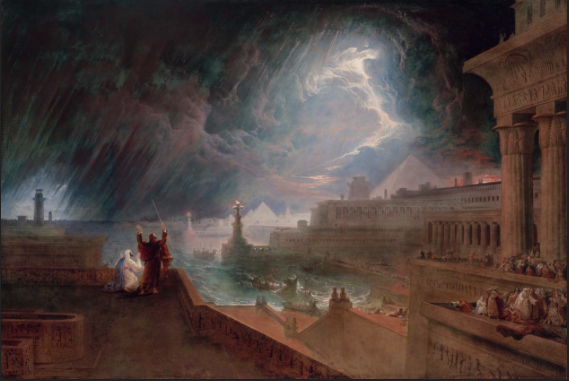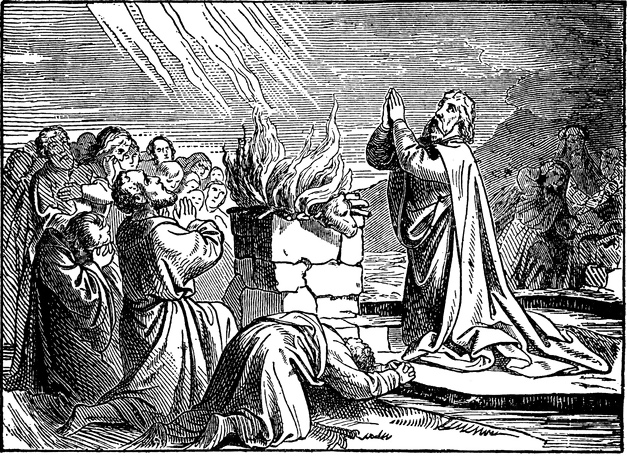“Then if you walk contrary to me, and will not hearken to me, I will bring more plagues upon you.” (Lev. 26:21)
The stoppage of ALL public Catholic Masses in the United States, and in many places around the world, is unprecedented. We know that private celebrations of the Mass by priests continue, but nevertheless, public Masses have ended. One has to go back to the 300’s A.D. in Rome, before Christianity became legal with Emperor Constantine, to find a time when no public Masses were offered anywhere. The Eucharist and the Mass are the source and summit of the Catholic faith. Yet, there is a blackout of public Masses everywhere now. This should grab our attention.
The Old Testament offers many examples when God grabbed the undivided attention of his people by sending plagues upon them too. This does not mean that plagues are synonymous with sin. There is not a one-to-one correlation, as Jesus said in the New Testament (John 9:3). It does not mean someone suffering from the virus, or any other ailment for that matter, has sinned in some way. No, not at all – think of the righteous, but long-suffering, plague-afflicted man, Job.
However, the Bible does make it abundantly clear that plagues can be a tool that God uses to discipline his people and to draw them back to himself. A good father chastises his children when they make bad choices, or are doing something harmful to themselves or others. The global size, scope, and unprecedented nature of the current COVID-19 pandemic suggest something unique is happening.
We, as a Church and a society, continue to stubbornly embrace a moral turpitude against the sanctity of life and marriage and the family. Furthermore, there are unresolved ecclesiastical sexual scandals within the hierarchy of the Church. Others have even made the connection to the public, fertility-goddess ceremony of the pachamama idol in the Vatican during the Amazonian synod last fall and the current outbreak. There is no denying that a certain laxness has crept into the Church in belief and in practice. We see this reflected in flippant casualness in regards to the Real Presence of Christ in Blessed Sacrament. This same lessening of the faith can be discerned in the other sacraments as well, like infrequent Confessions. Worse still, some have left the Church all together. In short, there has been a general falling away from the faith.
In similar instances in the Old Testament, God called his people a “stiff-necked people” (Ex. 32:9), because they were stubborn, obstinate, and recalcitrant in their sins and unbelief. When they refused to repent, God did at times send plagues upon them. In the Book of Exodus, God dealt with the hard-heartedness of pharaoh by sending ten plagues upon him and the Egyptians for not letting his people, the Israelites, go free to worship Yahweh. The last plague, the death of the firstborn sons, led to the freeing of the Israelites, and the institution of the Passover sacrifice. Out of the plagues, God ultimately brought something good, as pharaoh finally relented and let his people go.
The plague that brought the first Passover is the same Passover sacrifice that Christ celebrated at the Last Supper, or the first Catholic Mass. The Passover sacrifice was a prefigurement to the sacrifice of Christ on the Cross, the true Paschal Lamb of God, and the Eucharist. It is the same public sacrifice that God permits now to be stayed by a plague.
It was not just the Egyptians who had to contend with plagues because of their hard-heartedness. The Israelites, too, in their wilderness wanderings often times strayed from the will of the Lord, descending into idolatry and immorality. Even at the foot of Mount Sinai, the mountain of God, as Moses was receiving the Law, the Israelites worshipped the golden calf and “rose up to play,” a euphemism for sexual immorality. God immediately answers this with a plague: “And the Lord sent a plague upon the people, because they made the calf which Aaron made.” (Ex. 32:35)
There are numerous other instances throughout the Old Testament that God chastises his own beloved people through plagues:
- “While the meat was yet between their teeth, before it was consumed, the anger of the Lord was kindled against the people, and the Lord smote the people with a very great plague.” (Num. 11:33)
- “behold, the Lord will bring a great plague on your people . . . ” (2 Chron. 21:14)
- “they provoked the Lord to anger with their doings, and a plague broke out among them.” (Psalms 106:29)
We get the point. Plagues are one means that God turns us away from sin and leads us back into obedience and sanctity. It is a wake up call. Sin has consequences. This is not something our sophisticated modern ears really want to hear. To our insulated Disney World perspective of life, if you will, these are foreign concepts. The reality of sin and just punishment is something we wrestle with. Yet, here we are.
This corona event may be a necessary prick to our consciences. But, one may ask, for what reason? Perhaps, it is a reminder that God is in control, and he has established his unchanging law and commandments that we are obliged to follow. The coronavirus has been an earthquake to our society, to the world, in terms of our collective health, economy, and way of life. It is an unmistakable call to penance. We avoid activities now that would endanger our mortal bodies, but what about preserving our immortal souls? This is a spiritual event. It is like a large, blinking, neon yellow “CAUTION” sign to stay on the straight and narrow path to eternal life.
The physical crisis is a symptom of our underlying spiritual crisis. It is meant to wake us from our spiritual slumber. We know that God only allows evil for an ultimate, though mysterious, greater good. Scripture tells us that God “desires all men to be saved.” (1 Tim. 2:4) Our heavenly Father wants every single one of us to be in Heaven with him. We must play our part though by turning away from sin, and offering repentance and prayer. This great momentary pause in things is an opportunity for us. It is our monastic moment, cloistered in our homes, to examine honestly the state of our souls. Perhaps, if we loosen our stiff-necks and turn away from sin, then later, like the Israelites, we may enter into the Promised Land.


